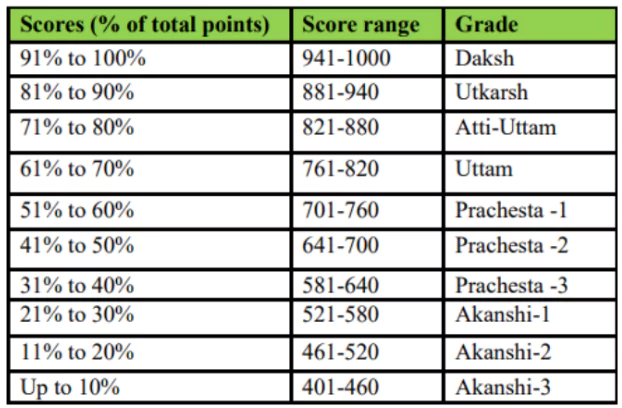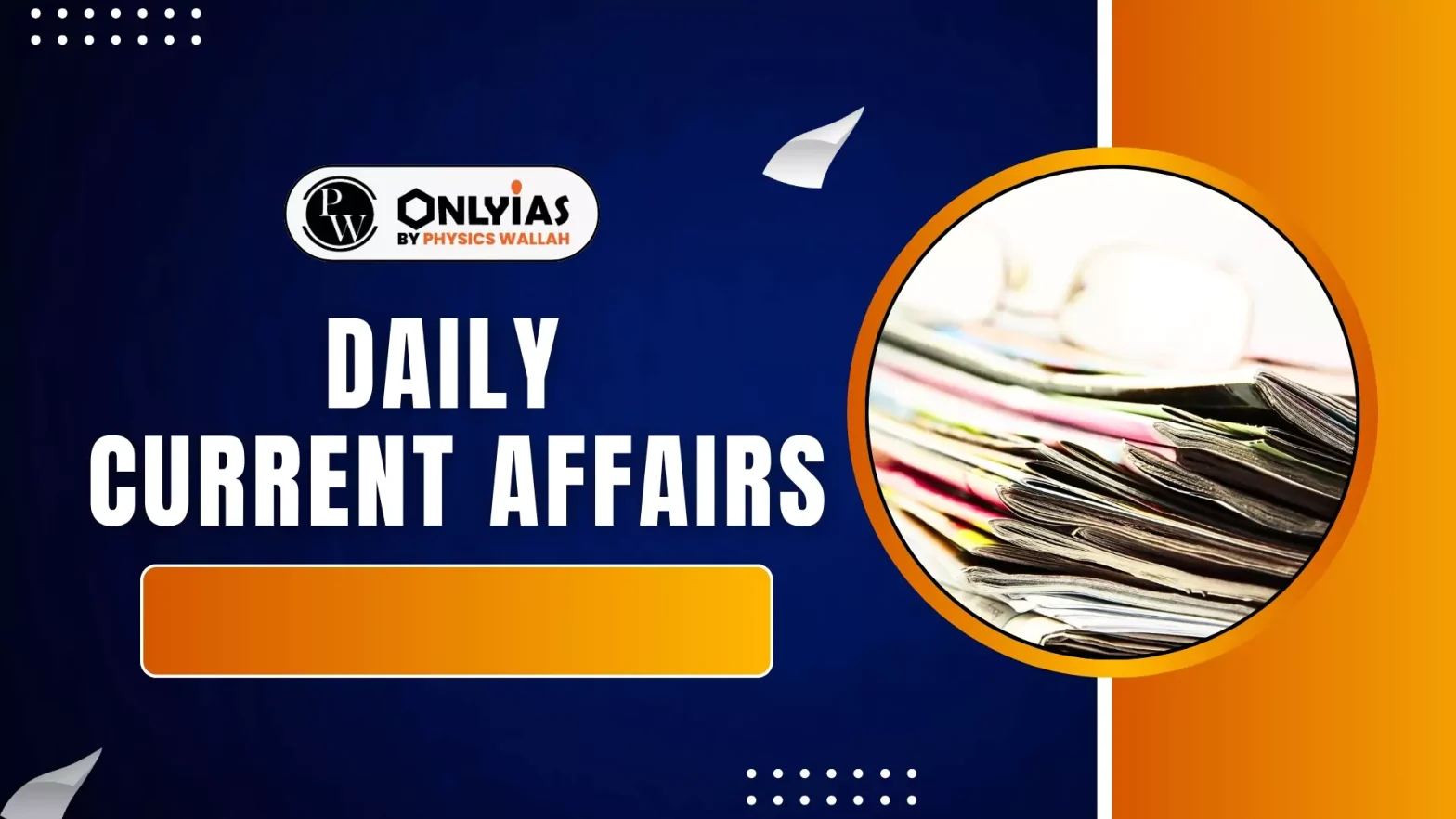Recently, the Performance Grading Index (PGI) 2.0 report was released by the Union Ministry of Education.
About Performance Grading Index (PGI)
- The Performance Grading Index (PGI) is an assessment tool developed by the Ministry of Education, Government of India.
- It measures the performance of States and Union Territories (UTs) in the school education system based on a wide range of indicators.
- Launch Year: The PGI – States/UTs was first released for the year 2017-18.
- Released by the Ministry of Education.
- PGI 2.0: Revised and updated version of the PGI (started from 2021-22) designed to assess the performance of States and Union Territories (UTs) in the school education system.
Key Features of PGI 2.0
- Revised Structure: PGI 2.0 replaced the earlier PGI structure (2017-2021) to align with National Education Policy (NEP) 2020 and Sustainable Development Goal (SDG) 4.
 Indicators: Focus shifted to quality indicators in addition to governance and digital initiatives.
Indicators: Focus shifted to quality indicators in addition to governance and digital initiatives.- Source of Data: Primarily sourced from UDISE+ (Unified District Information System for Education Plus).
- Grading System: PGI 2.0 introduces a scale from Akanshi-3 (lowest) to Daksh (highest).
- Total Points: 1,000 points across 73 indicators divided into two categories: Outcomes and Governance Management (GM).
Domains of PGI 2.0
PGI 2.0 assesses school education under 6 domains:
- Learning Outcomes (LO): Student performance in key subjects and overall academic achievement.
- Access (A): Enrolment rates, retention, and transition from one grade to another.
- Infrastructure & Facilities (IF): Availability of essential infrastructure like toilets, clean water, electricity, etc.
- Equity (E): Addressing disparities in access to education based on socio-economic factors.
- Governance Processes (GP): School management practices, accountability, and data-based decision-making.
- Teacher Education and Training (TE&T): Professional development of teachers and their effectiveness in the classroom.
Grades in PGI 2.0

- Daksh (Top Grade): Scores above 940/1000.
- Akanshi-3 (Lowest Grade): Scores up to 460/1000.
- Other Grades: The intermediate grades range between these extremes, with each reflecting the state of development in key areas of school education.
- Daksh: Top-performing States/UTs.
- Grade 1 to Grade 9: Cover various stages of performance, with corresponding improvements in quality, governance, and infrastructure.
- Akanshi-2 and Akanshi-3: Represent the underperforming States/UTs needing significant intervention.
Key Highlights of the Performance Grading Index (PGI) 2022-23 & 2023-24
- Top Performers
- Best Performer: Chandigarh achieved a score of 703 in Prachesta-1, showing improvements in infrastructure, governance, and teacher training.
- Notable Improvement: Bihar and Telangana showed the highest improvements in access to education, particularly in enrollment and retention.
- Low Performers
- Lowest Rank: Meghalaya scored 417, falling into the Akanshi-3 category.
- Other Low-Performing States: Telangana, Assam, Jharkhand, Tripura, Manipur, Chhattisgarh, and Bihar are in the Akanshi-2 category.
- Improvements in Specific Domains
- Learning Outcomes: Despite improvements in infrastructure, no state reached the top grade in learning outcomes (Daksh).
- States like Chandigarh, Punjab, and Puducherry ranked higher, but gaps remain in foundational literacy and numeracy.
- Access: Odisha topped the Access domain with the Daksh grade.
- Bihar and Jharkhand made the highest progress in enrollment and retention.
- Infrastructure & Facilities: Chandigarh had the highest score, closely followed by Delhi and Jammu & Kashmir.
- Key facilities like toilets, electricity, and digital infrastructure were improved significantly.
- Equity: States showed consistent progress in narrowing the gap in educational access for marginalized communities, including SC/ST students.
- Governance Processes: Chandigarh scored the highest in this domain, reflecting effective governance, transparency, and accountability.
- Teacher Education & Training: Chandigarh performed exceptionally well in this domain, securing Daksh grade.
School Education in India
- India has one of the largest school education systems globally, with 24.8 crore students in 14.72 lakh schools supported by a dedicated workforce of 98 lakh teachers (UDISE+ 2023-24).
- The system faces challenges in quality, retention, and infrastructure, despite high enrollment.
- Structure of School Education
-
- Pre-Primary: Play schools, kindergarten.
- Primary (Classes I-V)
- Upper Primary (Classes VI-VIII)
- Secondary (Classes IX-X).
- Higher Secondary (Classes XI-XII)
Key Features of School Education in India
- Government and Private Schools: As per Economic Survey 2024-25
- Government Schools: About 69% of schools are government-run, serving 50% of students.
- Private Schools: Account for 22.5% of schools, enrolling 32.6% of students.
- NEP 2020 aims for a 100 % Gross Enrolment Ratio (GER) by 2030.
- Curriculum and Pedagogy:
- Curriculum Framework: Developed by NCERT (National Council of Educational Research and Training) and followed by SCERT (State Council of Educational Research and Training) at the state level.
- School Boards:
- CBSE (Central Board of Secondary Education)
- ICSE (Indian Certificate of Secondary Education)
- State Boards
- Exams and Assessment:
- Students appear for board exams at the end of Class X (Secondary) and Class XII (Higher Secondary).
- Various internal assessments and national surveys like the National Achievement Survey (NAS) are conducted to evaluate students’ learning outcomes.
Key Statistics
- Enrolment Statistics
-
- Total Students: 24.8 crore students enrolled in the education system.
- Primary Education: Near universal enrollment (Gross Enrollment Ratio at 93% for primary education).
| Dropout rate is the proportion of pupils from a cohort enrolled in a given level at a given school year who are no longer enrolled at any grade in the following school year.
Retention rate is the percentage of a cohort of pupils (or schools) enrolled in the first grade of a given level of education in a given school year who are expected to reach the last grade of the level.
The Gross Enrolment Ratio (GER) is the number of children enrolled in an education level relative to their population. |
-
- Secondary Education: 77.4% GER at the secondary level (Grades IX-X).
- Higher Secondary: 56.2% GER at the higher secondary level (Grades XI-XII).
- Dropout Rates (UDISE+ 2023-24):
- Primary (Classes I-V): 1.9%
- Upper Primary (Classes VI-VIII): 5.2%
- Secondary (Classes IX-X): 14.1%
- Retention Rates (Economic Survey 2024-25):
- Primary (Classes I-V): 85.4%
- Elementary (Classes I-VIII): 78%
- Secondary (Classes I-X): 63.8%
- Higher Secondary (Classes I-XII): 45.6%
- Pupil-Teacher Ratio (PTR)
- The national average Pupil-Teacher Ratio (PTR) is approximately 1:30 for primary education
- Senior Secondary Schools: At senior secondary level, the PTR is 47:1.
Key Progress in School Education in India
- Near-Universal Enrollment: Primary education enrollment is near 100% with 93% GER for children aged 6-10 years.
- Improvement in Infrastructure: 96% of schools have girls’ toilets.
- 91.8% of schools are equipped with electricity.
- 38.5% of schools have computing devices, and 22.3% have internet access.
- Progress in Learning Outcomes: 60% of Grade I students struggle with basic math problems (1-digit addition).
- 50% of Grade III students cannot read Grade I-level text.
- Teacher Availability: The teacher-student ratio has improved, though there are still over 1 million vacancies across the country.
- Increase in Retention Rates: 85.4% retention for primary school (Classes I-V), with lower dropout rates than before.
- Use of Technology: DIKSHA platform has been adopted in 100% of schools, providing digital content and resources for teachers and students.
- Focus on Gender Parity: Girls’ enrollment in primary school is nearly equal to that of boys, with consistent improvements in gender equity in access to education.
Key Government Schemes & Initiatives
- Samagra Shiksha Abhiyan: Holistic education from pre-primary to Class XII, aligned with SDG-4 and NEP 2020.
- Components:
- Infrastructure development (new schools, ICT labs, smart classrooms).
- Inclusive education for Children with Special Needs (CwSN) (ramps, Braille kits, stipends).
- Free textbooks, uniforms, transport allowance.
- Vocational education (9,477 schools covered).
- Achievements (2018-19 to 2024-25):
- Upgraded 3,656 schools, constructed 80,105 additional classrooms.
- 1,38,802 schools covered under ICT & digital initiatives.
- 58.5% of government schools have ramps; 31.1% have CwSN-friendly toilets.
- PM SHRI (PM Schools for Rising India): Develop 14,500+ model schools showcasing NEP 2020 implementation.
- Features:
- Smart classrooms, science labs, skill labs, playgrounds.
- 12,084 schools selected (as of 2024).
- Budget: ₹27,360 crore (5-year plan).
- PM POSHAN (Mid-Day Meal Scheme): Address hunger & improve education via hot cooked meals for pre-school to Class VIII.
- Innovations:
- Tithi Bhojan (community participation).
- School Nutrition Gardens (fresh produce for meals).
- Increased material cost per child (₹6.19 for primary, ₹9.29 for upper primary).
- ULLAS (Nav Bharat Saaksharta Karyakram): Adult literacy for non-literates aged 15+ (Foundational Literacy, Vocational Skills).
- Achievements:
- 2 crore learners, 39 lakh volunteer teachers registered.
- Ladakh declared first fully literate administrative unit (June 2024).
- 88.89 lakh certified literates through FLNAT.
- Foundational Literacy & Numeracy (FLN)
- NIPUN Bharat Mission: Ensure Grade 3 students achieve FLN by 2026-27.
- FLNAT (Assessment Test): 1.11 crore learners appeared, 88.89 lakh certified (2024).
- PARAKH (National Assessment Centre): Standardize assessments across school boards.
- PARAKH Rashtriya Sarvekshan 2024: Assessed 23 lakh students (Grades 3, 6, 9).
- Holistic Progress Card (HPC): Competency-based tracking of student progress.
- Digital Initiatives
- DIKSHA: Digital platform for teacher training & e-content.
- SWAYAM: Online courses for Classes IX-XII.
- PM e-Vidya: DTH channels for remote learning.
- APAAR ID: Unique student ID for tracking progress (7 crore generated by Dec 2024).
- Eco Clubs for Mission LiFE: Aligned with 7 sustainability themes (e.g., Save Water, Reduce Waste).
- Tribal & Rural Education
- PM-JANMAN: Focuses on 75 Particularly Vulnerable Tribal Groups (PVTGs).
- 100 hostels approved (2023-24).
- Dharti Aaba Janjatiya Gram Utkarsh Abhiyan (DA-JGUA): Construct 1,000 hostels for ST students.
Challenges in School Education in India
- Poor Learning Outcomes: Students face significant difficulties in foundational literacy and numeracy.
- 60% of Grade I students struggle with basic addition, and 50% of Grade III students cannot read Grade I-level text.
- High Dropout Rates: Retention rates decrease significantly as students progress through grades.
- 85.4% retention at primary level, but only 45.6% retention at the higher secondary level.
- Teacher Shortages: India faces a significant shortage of qualified teachers in government schools.
- Over 1 million teacher vacancies exist, and many teachers lack adequate qualifications for their subjects.
- Inadequate Infrastructure: Schools often lack basic infrastructure, particularly for disabled students.
- 58.5% of government schools lack ramps and 31.1% lack Children with Special Needs –CWSN-friendly toilets.
- Gender Disparity: Girls face barriers to education, particularly in rural areas.
- While schemes like Kasturba Gandhi Balika Vidyalaya (KGBVs) help, gaps persist in access and retention for girls.
- Poor Integration of Technology: Schools have limited access to technology, hindering digital learning.
- While 91.8% of schools have electricity, only 38.5% have computers.
- Lack of Accountability and Monitoring: Weak governance and monitoring hinder improvement efforts.
- Lack of real-time data makes it difficult to track progress and address educational gaps effectively.
Case Studies: Innovative Approaches in School Education in India
- Mission Ankur in Madhya Pradesh & Gujarat: Early childhood education and foundational literacy and numeracy (FLN).
- Mission Ankur engages schools and communities for holistic development, ensuring FLN for primary students through personalized teaching methods and community involvement.
- Mission Daksh in Bihar: Personalized mentoring for underperforming students.
- The initiative focuses on providing individualized support to students lagging behind, aiming to help them meet grade-level competencies by 2025.
- Nalli-Kali Program in Karnataka: Peer and group-based learning in primary education.
- The program uses peer teaching and collaborative learning to enhance student engagement, focusing on self-paced learning for children in Grade 1 to 3.
- Prerana Model of Education: Peer learning and group work in states like Andhra Pradesh, Karnataka, Maharashtra, Tamil Nadu, and Telangana.
- Small group activities help students collaborate and teach each other, improving their comprehension and problem-solving skills.
- The Tim Tim Tare Initiative: Imparting life skills to adolescents.
- The program teaches emotional intelligence, problem-solving, and social skills to adolescents through interactive and activity-based learning.
- Impact: Over 10 crore students have benefited, helping them navigate modern life’s complexities with improved communication and self-management.
- Illam Thedi Kalvi (Education at Doorstep) in Tamil Nadu: Bridging the educational gap caused by the COVID-19 pandemic and digital divide.
- Volunteers conduct door-to-door education for students, especially in rural areas, using play-based learning and physical methods.
- Shanti Bhavan School, Tamil Nadu: Inclusive education for underprivileged children.
- Shanti Bhavan offers a values-based education with a strong focus on holistic development. The curriculum includes leadership training and community involvement.
Global innovative examples
- The Khan Academy Model (USA): Flipped classroom and online learning.
- Students access pre-recorded lessons and instructional videos on Khan Academy at home. Classroom time is used for discussions, exercises, and peer learning.
- Project-Based Learning at High Tech High (USA): Collaboration and real-world problem-solving.
- Students engage in projects that require them to collaborate, research, and create tangible solutions to real-world problems. The projects integrate multiple disciplines, such as science, math, and humanities.
- The Green School, Bali (Indonesia): Sustainability and environmental education.
- The school’s curriculum is deeply integrated with environmental sustainability. Students learn through hands-on experiences such as organic farming, renewable energy projects, and waste management.
- Mindfulness Education at The Calm Classroom (USA): Social-emotional learning (SEL) and mindfulness.
- The Calm Classroom program helps students manage stress and enhance focus through mindfulness exercises, deep breathing, and meditation practices.
- Summit Learning Program (USA): Personalized learning and student-centered education.
- Summit Learning provides students with personalized learning plans (PLPs) that allow them to progress at their own pace. Students set goals and manage their own learning, supported by mentors and adaptive assessments.
- The Reggio Emilia Approach (Italy): Early childhood education through creativity and inquiry.
- The Reggio Emilia approach encourages children to learn through play, exploration, and hands-on experiences. Teachers act as guides and co-learners, fostering a child-centered, interactive curriculum.
|
Way Forward for School Education in India
- Strengthen Early Childhood Care and Education (ECCE): Implement competency-based learning for children from birth to age 6, focusing on foundational literacy and numeracy.
- Bridge the Digital Divide: Expand digital education initiatives like DIKSHA and PM eVidya to ensure internet access in rural schools, improving digital literacy.
- Enhance Teacher Training and Professional Development: Scale up teacher training programs like NISHTHA and PRERANA, incorporating AI and digital tools for continuous learning.
- Promote Inclusive Education: Increase the number of accessible schools with assistive technologies and implement inclusive classrooms for Children with Special Needs (CwSN).
- Focus on Social and Emotional Learning (SEL): Expand SEL programs in schools to build emotional intelligence, resilience, and overall well-being among students.
- Improve Infrastructure and Facilities: Ensure basic amenities like toilets, electricity, and ICT tools in all schools, especially in rural and underserved areas.
- Integrate Vocational Education and Skills Development: Promote multi-disciplinary education by integrating vocational training and life skills into school curricula to prepare students for the future workforce.
Conclusion
The PGI 2.0 report for 2022-23 and 2023-24 highlights significant progress in India’s school education system, with top performers like Chandigarh leading in infrastructure and governance, yet challenges like poor learning outcomes and high dropout rates persist. Sustained efforts in implementing NEP 2020, enhancing teacher training, and bridging the digital divide are crucial to achieving equitable, quality education for all.
Additional readings: National Education Policy 2020, Experiential Learning
![]() 20 Jun 2025
20 Jun 2025

 Indicators: Focus shifted to quality indicators in addition to governance and digital initiatives.
Indicators: Focus shifted to quality indicators in addition to governance and digital initiatives.

